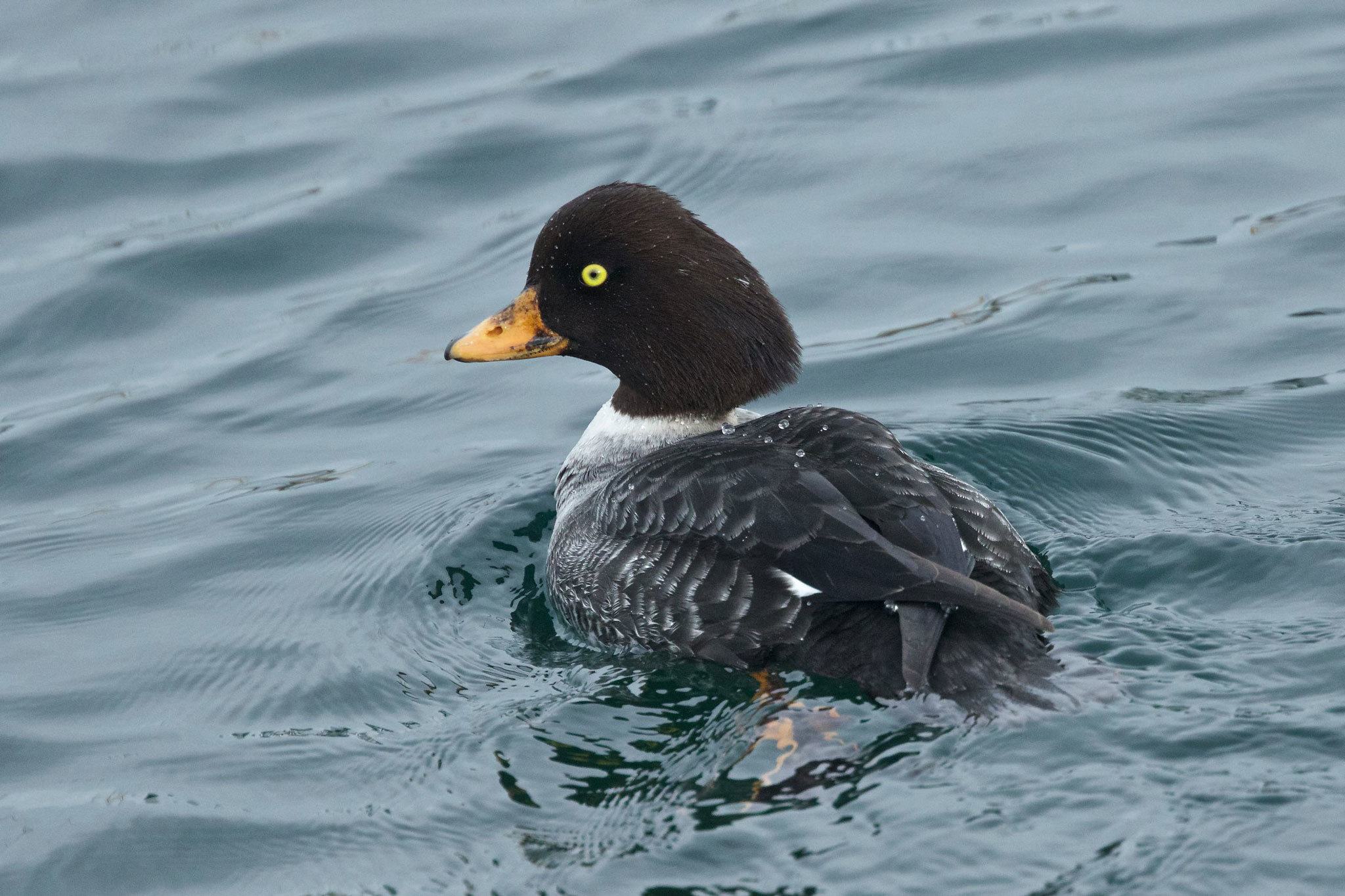I seem to be challenging you, my readers, to go out and find some of these birds for me! I find I am stuck behind a computer far too often for my birding needs, so I am hoping I can convince some of you to get out there and check out the wonderful birds we have right here in our own back yards … loosely speaking. This photo of a female Barrow’s Goldeneye was taken by Gregg Thompson.
General Description: The Barrow’s Goldeneye is a sturdy, diving duck which is a true PNW native, spending the bulk of the year in our fresh-water mountain lakes and ponds, and in the winter they prefer salt-water estuaries, protected bays, and large lakes with sandy, gravel, or rocky bottoms. They measure 16.9 to 18.9 inches in length with a wingspan of 28 inches, and weighing 2.1 pounds. The main things that distinguish the Barrow’s from the Common Goldeneye are the forehead shape … rather steep, almost vertical forecrown on the Barrow’s and a more gradual slope on the Common Goldeneye. The head of the Barrow’s female is a darker brown than the Common, and the bill of the Barrow’s is smaller and mostly yellow with a black tip, while the bill of the Common is mostly black with a yellow tip. Male Barrow’s Goldeneyes have iridescent purple heads that look black when not in the sunlight, while a Common male has a green head. The male adult breeding Common has a round, white loral (cheek) patch while the Barrow’s patch is crescent or triangle-shaped. The breeding male Common Goldeneye has mostly white sides and back while the male Barrow’s Goldeneye is mostly black with white elongated spots.
Habitat: The Barrow’s Goldeneye is found throughout the western mountainous area of North America and prefers small, clear lakes and ponds free of vegetation and fish. As cavity-nesting birds, they are found in forested area where they can make use of mature trees with suitable holes for nests. They breed farther north than the Common Goldeneye, some even above the tree line.
Behavior: Goldeneyes are diving ducks and can be seen diving en mass, which makes for interesting photo opportunities. They forage mostly underwater, often around pilings, and fiercely defend their feeding and breeding territories. The males are known for their spectacular and complex courtship displays to broadcast “mine.” Females commonly lay their eggs in the nests of other ducks, including other Barrow’s Goldeneye nests, especially if the other nests are in cavities.
Diet: Aquatic insects are the main food of the breeding goldeneyes, which is why they prefer lakes and ponds that lack insect-eating fish that compete for prey. In winter they switch to mollusks, crustaceans, fish and fish eggs.
Nesting: Female Barrow’s Goldeneye don’t start breeding until they are about three years old and will return to the same area they were hatched. They also return to the same nesting site year after year. Pairs form in late winter, staking claim to cavities in large trees or nest boxes, or even depressions in rock crevices, abandoned buildings, burrows, or bushes on the ground. They reuse existing materials from previous years, such as wood chips and leaves, lined with down. The female lays 6 to 12 eggs and incubates them for 29 to 31 days, while the male leaves for his molt migration. They will re-establish their pair bonds in the fall. The young leave the nest one to two days after hatching and the female leads them to an area where they can feed for themselves. Sometimes several broods join and create large groups of youngsters, especially if broods are either abandoned or mixed up in territorial disputes between females. The females abandon their young before they can fly, usually at 5 to 6 weeks of age. They fledge at 8 to 9 weeks.
Migration: After the males undergo their molt migration they have another medium migration late in the fall, from their staging areas to their winter grounds. They often arrive late in October or early November, with the males arriving a few weeks earlier than the females and the young. The spring migration begins in late February.
Conservation Status: The Barrow’s Goldeneye is more restricted in range than the Common and therefore more threatened by potential threats of oil spills, heavy metal accumulation in prey, recreational development on nesting lakes, and loss of habitat from logging. The population on the Pacific coast is 90 percent of the world population, increasing the significance of local threats to the population as a whole. There is also some question whether current surveying techniques are adequate for this species.
When and Where to Find on Grays Harbor: In winter, Barrow’s Goldeneyes are uncommon but can be found in coastal bays and estuaries, much closer to shore than Common Goldeneyes. They are a tough duck to find out here but they can be found; it just takes a whole lot of patience and a bit of luck…as usual. Good birding.


